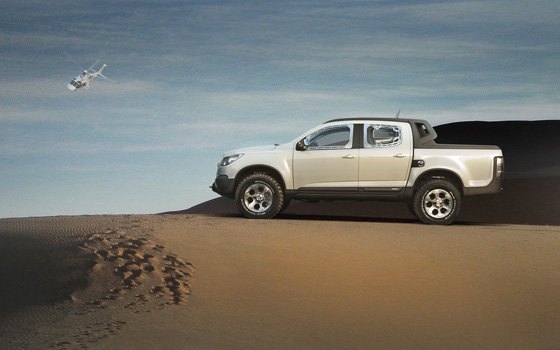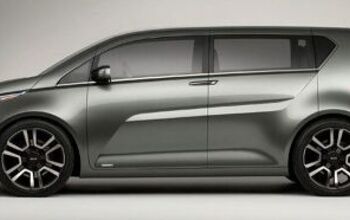A Glimpse Of Chevy's Compact Pickup Future
Well, we’ve accidentally developed something a of a Chevy theme this morning, what with the Cobalt and 2013 Malibu… and now this, the Colorado Rally Concept, a first look at the next generation of GM compact pickups. Though the concept’s 2.8 liter turbodiesel engine is unlikely to make it to the US, Pickuptrucks.com reports
According to manufacturing documents we’ve obtained, the Colorado’s start of regular production is slated for Oct. 3, 2011, in Thailand and Jan. 16, 2012, in Brazil, where it will likely be sold as the S-10.
According to our sources, the code names for the Chevrolet Colorado and GMC Canyon versions for North America are 31XC and 31XG. Start of U.S. manufacturing is scheduled for around July 2014, though production of the current Colorado and Canyon are expected to end by 2012 at the plant in Shreveport, La.
Aimed directly at the global pickup segment defined by Toyota’s HiLux and Ford’s Global Ranger, the Colorado looks to be larger than the typical compact pickup and represents a fundamentally different strategy than Chrysler’s planned minivan-based “lifestyle pickup.” And don’t look now, but tough midsized trucks like this could be as much a replacement for current full-size buyers as gas prices and CAFE standards rise, as they could be true entry-level compacts. But then, we’ll need to see how much this global vehicle is modified for the US market before we really know what we’re getting here.
More by Edward Niedermeyer
Latest Car Reviews
Read moreLatest Product Reviews
Read moreRecent Comments
- Sobhuza Trooper That Dave Thomas fella sounds like the kind of twit who is oh-so-quick to tell us how easy and fun the bus is for any and all of your personal transportation needs. The time to get to and from the bus stop is never a concern. The time waiting for the bus is never a concern. The time waiting for a connection (if there is one) is never a concern. The weather is never a concern. Whatever you might be carrying or intend to purchase is never a concern. Nope, Boo Cars! Yeah Buses! Buses rule!Needless to say, these twits don't actual take the damn bus.
- MaintenanceCosts Nobody here seems to acknowledge that there are multiple use cases for cars.Some people spend all their time driving all over the country and need every mile and minute of time savings. ICE cars are better for them right now.Some people only drive locally and fly when they travel. For them, there's probably a range number that works, and they don't really need more. For the uses for which we use our EV, that would be around 150 miles. The other thing about a low range requirement is it can make 120V charging viable. If you don't drive more than an average of about 40 miles/day, you can probably get enough electrons through a wall outlet. We spent over two years charging our Bolt only through 120V, while our house was getting rebuilt, and never had an issue.Those are extremes. There are all sorts of use cases in between, which probably represent the majority of drivers. For some users, what's needed is more range. But I think for most users, what's needed is better charging. Retrofit apartment garages like Tim's with 240V outlets at every spot. Install more L3 chargers in supermarket parking lots and alongside gas stations. Make chargers that work like Tesla Superchargers as ubiquitous as gas stations, and EV charging will not be an issue for most users.
- MaintenanceCosts I don't have an opinion on whether any one plant unionizing is the right answer, but the employees sure need to have the right to organize. Unions or the credible threat of unionization are the only thing, history has proven, that can keep employers honest. Without it, we've seen over and over, the employers have complete power over the workers and feel free to exploit the workers however they see fit. (And don't tell me "oh, the workers can just leave" - in an oligopolistic industry, working conditions quickly converge, and there's not another employer right around the corner.)
- Kjhkjlhkjhkljh kljhjkhjklhkjh [h3]Wake me up when it is a 1989 635Csi with a M88/3[/h3]
- BrandX "I can charge using the 240V outlets, sure, but it’s slow."No it's not. That's what all home chargers use - 240V.





































Comments
Join the conversation
Genuinely small pickups used to sell in big numbers, but years of inexpensive fuel killed people's willingness to deal with cramped interiors. As small pickups were scaled up to have roomy, comfortable cabs, the entire trucks ended up bigger. Then they needed bigger engines and capabilities to match their size. I really like the idea of a sub-3,000 lb pickup that keeps up with traffic and gets 25 mpg with a 4-cylinder engine, but I was origamied into 1987 Toyota pickups when I was a 6'2" inch, 175 lb teenager. I'd be tortured as a 225 lb adult. Those little Toyotas were tough as nails, and I was impressed when I drove a rusty old leaf-sprung 4x4 Yota up a mountain stream bed, but even then I didn't want to contemplate having my knees in face while sitting 4 feet off the ground on a daily basis. My friend's 2008 Tacoma is a Range Rover by comparison. It only gets 18 mpg in DC traffic, but that's actually about what his car gets there too.
Chevy missed it. Nice looking truck and really like that rack in the back.. but no easy fold down midgate??? They should have built something that looked more like the 2001 k5 concept.